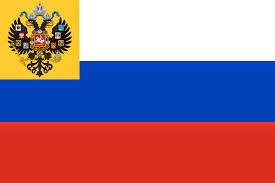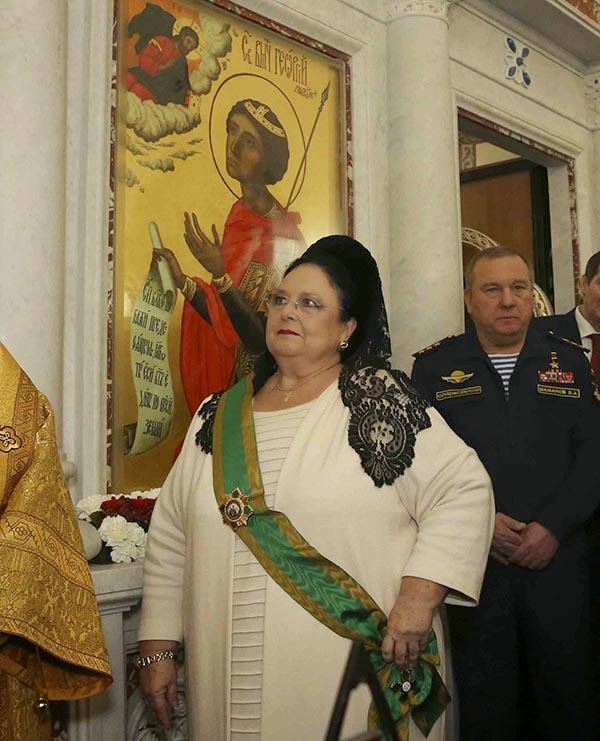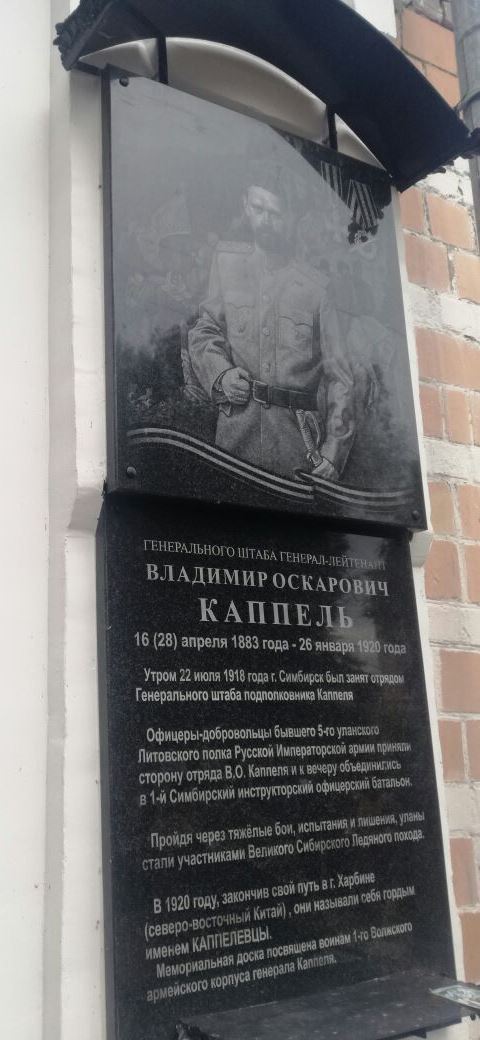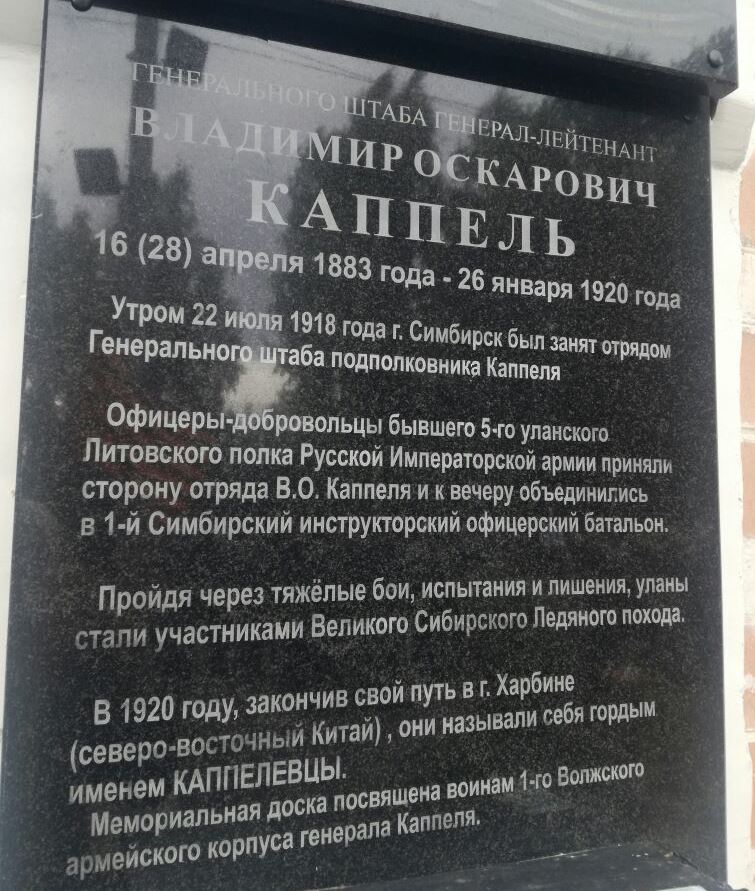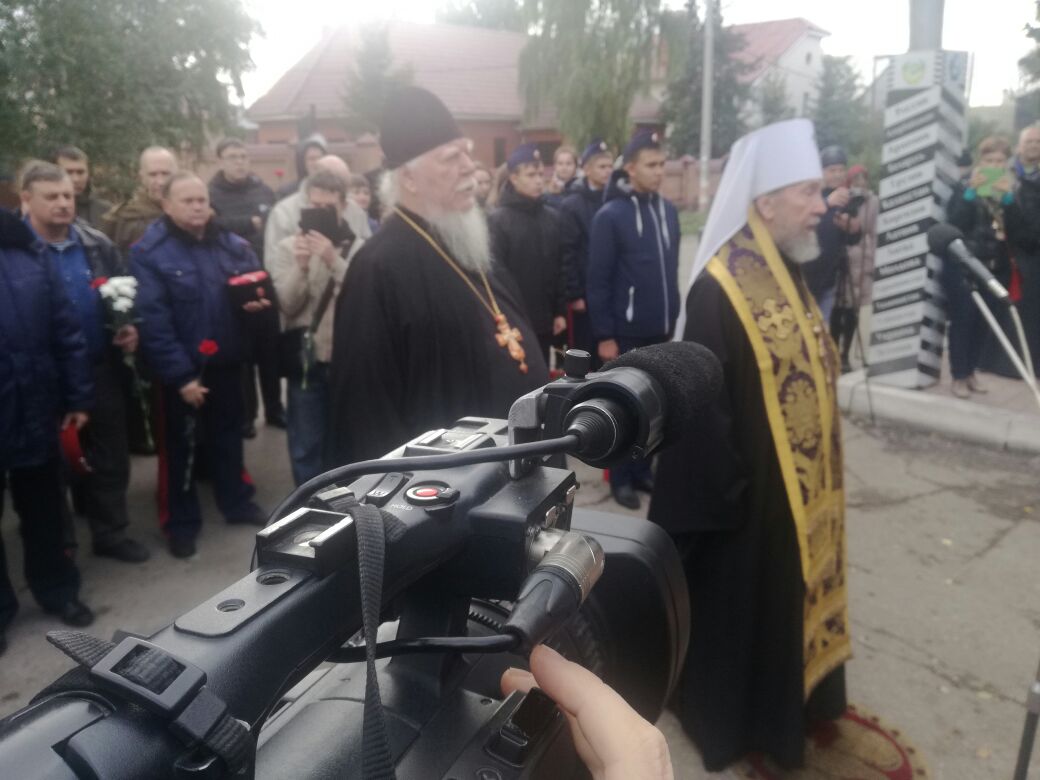The history of the “Inner Line” (VL), a counterintelligence service that was secretly located in Russian abroad, united primarily the EMRO officials (“lineans”) according to the principle of horizontal connections, aroused interest in emigration from 1937. At first, this was influenced by public reports, statements and an interview with public figures, and then due to the influence of historical journalism with a touch of indispensable mystery, conspiracy, and detective sensationalism1. However, genuine facts and evidence were mixed with legends, fantasies, and dubious testimony, often accompanied by numerous mistakes, hoaxes and speculation, hasty conclusions and conclusions of various authors. A major role in the distortion of events was played by the lack of objective information2.
The most famous in the “disclosures” of the VL was the George Knight, the trooper of the Don Don B. B. Pryanishnikov (1902-2002) 3 - the participant of the White movement in the South of Russia and the former ROVS rank, a member of the People's Labor Union (NTS) in 1933-1954 .4 The struggle of Boris Vitalyevich with a word and pen against the “Inner Line”, created, in his opinion, “from white officers, but captured by Soviet provocateurs” 5, in fact lasted half a century. At the same time, as V. G. Bortnevsky, a recognized expert in the history of Russian military émigrés, believed, Pryanishnikov accused the generals F. F. Abramov, P. N. Shatilova, captains K. A. Foss, N. D. Zakrzhevsky and others The “lineans” in the work of Soviet intelligence did not look reliable, based on an impartial analysis of the actual material ”6. V. G. Bortnevsky enthusiastically told the author of this publication about his plans to study the OHL materials, but the tragic death of a talented scientist in 1996 did not allow them to materialize.
The rich collection of the Chief of the General Staff of the General Staff, Lieutenant-General A.I. Arkhangelsky, which is kept in the Bakhmetevsky Archive of the Columbia University (Columbia University Libraries, Rare book and Manuscript Library, Bakhmeteff Archive), deposited documents on VL7. The study of the group of sources identified by us is relevant in connection with the history of the military organization (for example, in the test, ed.) Of the Russian diaspora and the counterintelligence work of emigrants in Bulgaria and France. The report of the “Special Commission” of the III (Bulgarian) ROVS Department, which worked under the guidance of Colonel Guards Artillery G.I. Petrichenko, report from May 9, 1939, the former head of the Cavalry General P.N. Shatilova, deserves special attention. , the testimony of one of the most famous "Lineans", the captain of the Drozdovsky artillery division, KA Foss8. The materials of the collection of General A.P. Arkhangelsky allow one to form an impression about the formation and main stages of the VL activities, supplement and verify information from other sources9.
General-Lieutenant A.I. Denikin believed that the creation of the VL was preceded by that founded in 1920-1921. the secret mafia in the depths of the White Army of the South10 is hinting in a letter to Arkhangelsk at some events allegedly known only to the head of the EMRO. Denikin was mistaken, partly due to the fact that in 1946, which dated his letter, the history of the OHL had already acquired a mythologized character. Especially since reliable information about the creation in 1920 - 1921. any "secret mafia" in the "depths" of the Russian army, Lieutenant-General Baron P.N. Wrangel researchers are unknown.
Even the authenticity of the name of the Organization11 by its opponents today is in doubt, after studying open sources. Foss in testimony to members of the commission Petrichenko reported that the term “Inner Line” itself arose in a public controversy (was “glued to us”) with the leaders of the NTSNP V.M. Baydalakov, M.A. Georgievsky, R.P. Ronchevsky and gained popularity among parts of immigrants to France. The unusual name for counter-intelligence officers of the EMRO liked it, and they themselves began to use it. It was finally established in 1937 as a result of “exposing” speeches against the overhead lines of the NTSNP members in France in connection with the abduction of the head of the EMRO Lieutenant-General Ye.K. Miller12. There are reasons to take Foss's version into account: the famous document “The Ideology of the Organization” dated October 1, 1933.13 did not use the phrase “Inner Line”. There is another explanation: “internal line” in Department III of the EMRO, unlike the “external line” (open lectures, teaching, briefing), was conventionally called conspiracy, invisible work - intelligence and counterintelligence activities14.
The history of the Organization, later called the VL, dates back to 1926. Its concept, according to the conclusion of commission members Petrichenko, belonged to Infantry General A. P. Kutepov, "who received great trust from the Velikiy (ich) Prince Nikolay Nikolayevich and appointed by the latter to direct all work on Russia "15. Thus, taking into account the results of previous investigations by V. G Bortnevsky, 16 it is appropriate to consider the creation of the Organization in close connection with the work of the Intelligence and Information Section of the Immediate Office of Grand Duke Nikolai Nikolayevich (the Younger), headed by Kutepov. In “Information No. 1” (Sofia, 1927) it was stated: “At the head of the Order is Kutepov, which he ordered to no longer hide from those initiates who had attached themselves to the struggle for the Motherland17. The Organization’s supreme goal declared “an implacable, tense struggle for Russia and the Russian People, for overthrowing the hated authority of the Third International and for creating a rule of law ensuring the maximum development of the country's spiritual and material forces” 18. The founder and head of the Organization in Bulgaria (until 1939) at the ROVS III department was Captain K.A. Foss19. According to his testimony, the captain-drozdovets P. M Trofimov, who lived in Prague and died while performing an assignment in the USSR in 1929, played an equally important role as the creator of the Organization.20 Kutepov saw as the main lines of activity of the Organization in the USSR , reconnaissance and communication with the anti-Bolshevik underground in the homeland, training of reservists from among the number of volunteer emigrants for secret work. And only in fourth place were intelligence and counterintelligence, agitation and propaganda in emigration. However, after the death of Kutepov in 1930, as a result of the narrowing of the material base, the increased difficulties in crossing the border, the dramatic change in the realities of life in the USSR and the psychological separation of emigration from Soviet reality, as well as due to the increased agent activity of the OGPU-NKVD abroad, the latter is secondary the direction naturally became the main and main21.
In the 1930s "Linear" in the first place engaged in the solution of two Problems. First, they worked in friendly organizations in order to preserve their influence and dependence on EMRO, using their capabilities from agitation and political to practical, including operations to transfer agents in the USSR. These included the League of Obera, the Russian Christian National Movement (then the Russian Labor Christian Movement), the Russian Falcon Society and, especially, the NNPA-NTSNP (“national boys”) 22. Secondly, the “lineans” covered for Voss, the heads of departments and the Union, the state of affairs in organizations hostile to the EMR, were introduced into their structures with the aim of “suppressing their activity harmful to the national cause” 23. Such were considered "returnees", Eurasians, Mladorossy, separatists (for example, the "Cossacks" of the Cossack National Liberation Movement (KNOD), and partly the Russian Imperial Union. In addition, the "Lineans" were charged with the task of strengthening the EMRO teams in the field, creating military circles -political training, combating criticism and rumors, discrediting EMRO, etc. For example, in the mid-1930s, of the 35 EMRO groups that existed in the French province, 22 were “linemen”, whose functions were imputed to “ help senior army group in p A bot to strengthen, solder and protect the group. ”24 It was not intended to join the OHL independently — the older candidate was suggested to the intended candidate after observing his activities and everyday behavior. However, despite the common stereotypes of A.I. Kutepov’s dream of creating a closed“ Order "Turned out to be a romantic illusion. There were no initiations into" linear ", no oath or commitment, no separate vertical structure with a single center of control, no" degrees of membership "- nothing that would cause VL with mafia or masonic lodge. In the best case, the candidates got acquainted on receipt with the text of the written instruction.
The “ideology of the Organization” of 1933 (12 pages of typewriting), to which Pryanishnikov attached such exceptional importance, in the first approximation looked mysterious, but described an ideal scheme that had never been possible to create. The thesis “there is no way out of the Organization” 25 looked sternly only on paper. In practice, a safe “exit”, that is, a withdrawal from cases, was not a problem for the counterintelligence officer. Some former “lineans”, without any consequences, then even opposed the EMRO, while others simply went into everyday life26.
The organization arose under the III division of the EMRO, therefore Bulgaria, where the VL was headed by Foss, became the main operational site of the work of the “lineans”, despite its primary importance for the Russian abroad of France. In 1934, at the meeting of the main employees of Foss, he was appointed two deputies. Captain of artillery A. A. Brauner, one of the creators of the NTSNP, became his closest ally in Sofia. In theory, Foss received reports from the “Lineans”, and on their basis he prepared reports for the Chief of Division III of the General Staff, Lieutenant General F. F. Abramov, who was in the know of all the VL events. However, in practice, the “lineans” at places also informed the heads of “their own” EMRO groups; therefore, horizontal links, not hierarchy, played the main role.
In the early 1930s. Foss took advantage of the relocation of "his" emigrants from Bulgaria to France, and thus "linear" began to conduct their work in the first division of the general from the cavalry P. N. Shatilova27. Sophia's French "lineans" did not submit, but, as members of the Petrichenko commission recognized, there was a "certain tendency" to this. In general, Foss believed that from Sofia he could not manage the "linemen" in France, and at best set them in common tasks. The following figures give an idea of the number of VL ranks: in France there were no more than 30 people29, and hardly more in Bulgaria. In Bulgaria, the “lineans” Voss managed to intensify the activities of a number of friendly youth organizations (the companies of the young shift of General Kutepov, the “Petrovtsy” - the National Organization of Russian Intelligence Officers, etc.). In this sense, work in Bulgaria advantageously differed from work in France, where the “linemen”, according to General EK Miller, repeatedly reported at the instance “sheer nonsense” and provoked friction with other people30. At the same time, the captain of the Markovsky artillery division and the “lineman” V. A. Larionov managed to successfully lead the White Idea youth circle in Paris 31.
The general leadership of counterintelligence officers in the first division of the EMRO was carried out by the captain of the Kornilovsk artillery division, N. D. Zakrzhevsky, who found himself a reputable patron in the person of the head of the division, General P. N. Shatilov. Miller, who did not tolerate a violation of the chain of command, believed that Shatilov decided to head the “lineans” voluntarily and voluntarily32. At the same time, Foss did not maintain contact with Shatilov, and his contacts with Zakrzhevsky consisted in the exchange of informational reports33. In turn, Shatilov considered Zakrzhevsky to be an observant officer, honest, but he was not ready for independent work, which probably explained his interference in the affairs of the “lineans”. The proposal to create a special charter for the VL, General Shatilov, rejected, and his role in the history of the VL was discontinued due to his departure from the post of Chief of the First Division of the EMRO in 1934. 34
So, the lack of a clear hierarchy, clear functions and structure led the VL to two results: if in Section III Foss worked safely in close connection with Abramov, then in France “linear” led by Zakrzhevsky claimed autonomous position, irritating General Miller35. In this sense, Foss was right when he said: “Everything was done under the flag of the EMRO and it was believed that the assembled frame is an instrument in the hands of one or another department head in which this apparatus exists.” 36 Of particular importance was the fact that involvement in overhead lines for relatively young EMRO officials served as a kind of psychological protest against the inertia of the old generals and staff officers who held commanding positions and, apart from the demands of honors, who were completely passive in social and political life.
From May-June 1935 until the end of December 1936, the Soviet agent Major General N. V. Skoblin was the person in charge of communication between the ranks of the OHL in France and Miller. At the same time, he was not a “lineman” before, entrusted to him with an assignment (perhaps not wanting to increase the risks of his failure) and repeatedly asked Miller to release him from his post37. Skoblin’s brief involvement with the “linemen” in France morally compromised them, but, in fact, no more than the officials of the Kornilov units. Nevertheless, for some contemporaries, the fact of Skoblin’s involvement with the “linemen” acquired an exaggerated significance. The loud “revelations” of overhead lines in France in the fall of 1937 were the result of the conflict of old and young immigrants that had been brewing for several years — not so much administrative-political as generational. At the same time, Miller’s abduction and Skoblin’s treason played a catalytic role. From the report of the Petrichenko commission it follows that the NSNP-NTSNP was created as a “political project” of the EMRO, and in the first half of the 1930s. Union was such. In 1935, in France, the EMR monthly deductions for the activities of NOSA were half of the local emigrant fees38. However, with the influx of new members to the “new generation”, their ambitions grew with the desire to get rid of the “wards” of the EMRO and then play an independent role in the life of the emigration. As a result, in Bulgaria, the EMRO officials began to leave the NTSNP in the summer of 1936, even before the scandalous "revelations" of Pryanishnikov. Later, the trend towards independence was also emphasized in the literature on the history of the NTS39. Of course, in the confrontation with the EMRO, the personal ambitions of the national youth, especially the leaders of the French department of the NTSNP, headed by V.D. Porem.
Public and mild accusations of Pryanishnikov and his associates of the “lineans” in “provocations” with vague hints of their dependence on Skoblin and involvement in Soviet agents, which were made at public meetings in the autumn of 1937, 40 were essentially a protest of “national boys” against obsessive aspirations “ controllers "from the OHL (captain ND Zakrzhevsky, lieutenant MI Seliverstov, etc.) to influence the activity of the NTSNP. The relationship between the two organizations was inevitably upset. December 18, 1937 the new head of the first division of the EMRO, Lieutenant-General V.K. Vitkovsky issued Circular No. 1597, which prohibited the ranks of Division I from being members of the NTSNP and the NTSNP assistance committees. The unwilling to leave the NTSNP was asked to leave the ranks of the EMRO in time to January 15, 193841
Thus, the sources identified by us suggest that under the generalized name “Inner Line” actually hid two modest counterintelligence services at the departments of the III and I division of the EMRO, which together consisted of several dozen people. In the fall of 1937, under the influence of the “growing pains” of the NTSNP and the conflict with the EMRO, the heavy impression of EK Miller’s abduction and N. V. Skoblin’s treason, emotions and ambitions created a far from reality image of an extensive semi-mafia organization, supposedly infiltrated "Soviet provocateurs." “I consider the [morning] Line to be an immoral and Jesuit organization,” wrote one of their staff officers from Paris on November 2, 1937. - Until now, almost no one knew about it. Now everyone knows. This is her first exposure. Int. [Morning] L. [ing] should be radically destroyed, and the EMRO again reorganized. For me the doubt about her connection with the Bolsheviks is incomprehensible, since the treachery of Sk. [Oblina] is open ”42. Blessed accusations impressed the senior officers of the EMRO who abolished the overhead lines in France43. In fact, the role, significance and operational capabilities of VL were extremely exaggerated and mythologized, especially in post-war journalism. Foss fantasy on the subject of VL annoyed and decades later. It is possible that this is why in 1964, in private correspondence, he compared Pryanishnikov with a “rash” 44.
In Bulgaria, the counterintelligence service under the Office of Department III existed in 1926–1941 (?), And its activities yielded certain results, including the activation of Russian youth organizations, as well as the exposure of a group of Soviet agents, primarily NF Abramov, 45 who had to leave Bulgaria In addition, the EMRO counterintelligence played an important role in the fate of some Soviet diplomats in Bulgaria, including FF Raskolnikov46. Perhaps that is why members of the Petrichenko commission offered overhead lines in Bulgaria "to maintain and, as far as possible, to develop further at all costs" only by rejecting the odious name47. This was done, and in the winter - in the spring of 1939, Captain K.A. Foss was replaced in the position of the Life Guard by Captain Ya.G. Yarenko48. In contrast, in France since the early 1930s. and until 1938"Lineans" acted inefficiently. They could not protect generals Kutepov and Miller, did not expose Skoblin, did not keep the NTSNP under the influence of EMRO, and their specific work in the EMRO provincial groups, reports, reports and other "awareness" still need objective research.
Nevertheless, the activities of the intelligence services, both single and small groups, were an integral part of the life of numerous military organizations of the Russian diaspora, numbering thousands of officials in Europe by 1939. The emigrant "activism", including the history of the "Inner Line", testified not only about their military-political potential, but also that the state of the civil war, the division between the Reds and the Whites persisted many years after the evacuation of the Crimea.
Literature
1 Inner line: the truth about the third trust. Public reports read in Paris by B. V. Pryanishnikov and I. A. Bryansky. Paris: Ed. KOVR of the NTSNP Department in France, 1937; Pe-Pepelovsky K. Regarding the articles about Generals Miller and Shatilov // Roll Call (New York). Ed.Department of the Society of Gallipoli, 1964. February-March. No. 146-147. Pp. 10-16; Scrolls N. [Stepanov N. F.] Inner Line (An ulcer on the body of Russian emigration): 1st ed.: San Paulo, 1964; 2nd ed .; San Pauelo: Ed. Journal "Vladimirsky Bulletin", 1966, etc. The list of materials and publications on the topic, see also: Pryanishnikov B. V. The Invisible Web. Cheka-OGPU-NKVD against white emigration / 2 ed. St. Petersburg: Rush Hour, 1993. C 460-464.
2 An example of disorienting essays on this topic is the journalism of the Moscow journalist A.S. Gasparyan (Gasparyan A.S. OGPU against the EMRO. The Secret War in Paris. 1924-1939. - Moscow: Veche, 2008). The fantasies and factual errors in the history of the VL and the EMRO, starting with the thesis that the VL that operated among the emigrants, “controlled their every step” (C 3), are encountered more than once (P. 4, 7, 30, 33, 38, 42 , 104, 132, 200, etc.).
3 Pryanishnikov B. V. The Invisible Web / 1 ed. [Silver Spring, MD], 1979; Pryanishnikov B.V. New Generations. First Edition. Sil-ver Spring. 1986. C 13-14, 22-31, 68-73.
4 In 1931-1936 the organization was called the National Union of a New Generation (NOSP), from February 1936 to November 1942. - The National Labor Union of the new generation (NTSNP), from November 1942 to July 1945. - National Labor Union (NTS), from July 1945 to July 1957. - National Labor Union (Russian solidarists).
5 Cit. by: Perepelovsky K. Regarding articles about Generals Miller and Shatilov // Roll Call (New York). 1964. February-March. 146-147. P. 11.
6 Bortnevsky V. G. B. B. Pryanishnikov and his book // Pryanishnikov B. V. The Invisible Web / 2 ed. Decree. cit. P. 459.
7 Columbia University Libraries, Rare book and Manuscript Library. Bakhmeteff Archive (BAR). Arkhangel'skii AP Collection. Box 5. Folder "Vnutrenniaia Liniia (1938-1950)".
1) [Secret report of the “Special Commission” of the Colonel G.I. Petrichenko III Division of the EMRO]. Top secret. Typescript. 24 l .;
2) Guard Colonel Petrichenko [G. AND.]. Drozdov Artdi-Vision p / colonel Mashinsky [N. V.], the Kornilov Impact Regiment, Colonel Kedrinsky [V. AND.]. Some thoughts on the future work of EMRO. Typescript, 8 p .;
3) Excerpts from the letters of Colonel S., composed of a member of the Committee for the Promotion of National Organizations in Paris. Typescript, 7 p .;
4) S.N.T. [Excerpts]. Typescript, 2 p .;
5-6) Copies: Order No. 15 of the EMRO, Belgrade, March 12, 1938. Typescript. Order No. 5 to the first division of the EMRO. Paris, March 1, 1938. Typescript, 4 p .;
7) Internal line. Captain Foss [Questionnaire]. Typescript;
8) Questions of members of the commission that conducted the investigation of the PFA [N. F. Abramova] (according to the 2nd information) [Questionnaire]. Typescript;
9) [Answers to questions from Captain K. A. Foss]. Typescript. 4 l .;
10) Head of the ERO Division III. Report. Typescript;
11) Cavalry General P. N. Shatilov - Chairman of EMRO, Paris, May 9, 1939. Typescript. 7 l .;
12) Final Protocol of the Commission in the Shipov case [N. F. Abramova]. Sofia, Feb 7 1939. Typescript. 3 l .;
13) Help, compiled in 1937 in Bulgaria. Typescript, 2 p .;
14) About personal impressions of life and work of Department III [EMRO]. Typescript.
8 Foss Claudius Alexandrovich (1897 - 1991) - a participant in the White movement in the south of Russia, captain of the Russian army (production in exile). In 1918, in the campaign Iasi - Don in the ranks of the 1st detached brigade of Russian volunteers of the General Staff Colonel M. G. Drozdovsky, then Junker of the 3rd separate light battery of the 3rd division of the Volunteer Army. Warrant Officer of Army Artillery (December 7, 1918), Second Lieutenant (1919). In the ranks of the All-Soviet Union of Civil Defense and the Russian Army (1919 - 1920) in the 3rd (since October 1919 - Drozdovskaya) artillery brigade. In November 1920, as part of the unit was evacuated from the Crimea. On December 18, 1920, by order No. 298 of Lieutenant-General P. N. Wrangel, he was promoted to lieutenant (with seniority since September 22, 1919), on December 24, 1920, by order No. 304 for military distinctions in staff captains (with seniority with 16 September 1920).As part of the Drozdov Artillery Division I Army Corps of the Russian Army in Gallipoli (1920 - 1921), then in exile in Bulgaria. Chin EMRO. Member of the conspiracy counterintelligence activities of the Union. On September 1, 1925 - in the rank of captain (after December 24, 1920) in the frames of the Drozdovsky Art Division (No. 235 in the list). In 1925 - 1941 in service in the Military Ministry of Bulgaria, Major for-pass. From 1926, the head of the intelligence and counterintelligence service under the Directorate of Department III of the EMRO (1926 - 1939) as appointed by the general of infantry, A. P. Kutepova. Clerk (secretary) of the Office of the Office III of the Division in Sofia. In 1929 - 1930 Head of the local department (representative office) of the Brotherhood of Russian Truth. October 3, 1933 elected a member of the board of the Department of the Society of Gallipoli in Bulgaria. Owned foreign languages:English, Bulgarian, German, French. Collaborated with representatives of the Bulgarian special services. In the winter of 1936 - 1937 For the first time, NF Abramov, an employee of the Office of the Third Division, was suspected of involvement in relations with Soviet agents. As a result of operational activities, on November 13, 1938, NF Abramov and his wife went to France (in fact, a mild expulsion) by the Bulgarian authorities. Mr. Yarenko. From the summer of 1941, with a group of EMRO officials in the occupied territories of the USSR, he worked along the line of the Abwehr in Nikolaev and other cities. In 1942 - 1943 Head of the “Russian Group” of the Marine Intelligence Team for the Black and Azov Seas (ANST “South of Ukraine”, FP No. 26830, Nikolaev).Then the officer of the Abwehr in Melitopol. In 1943 - 1944 conflicted with members of the NTS, under the leadership of Esaula E. I. Mamukov, who created their groups in Kirovograd, Nikolaev, Odessa, and other cities, but the causes and nature of this conflict need to be studied. For the differences in the service in the Wehrmacht awarded the Order of the Iron Cross Class II. In the winter of 1945, he tried to enlist in the KONR troops, but his candidacy was rejected by the head of the army headquarters, Major General F. I. Trukhin. After the capitulation of Germany, he was hiding in the American occupation zone in the Munich region, living under the surname “Aleksandrov”. He participated in counter-intelligence operations of the American special services. He was wanted by the state security organs of the USSR. In emigration to Germany. Since 1926 he survived more than ten attempts.under the leadership of Esaula EI Mamukov, who created their groups in Kirovograd, Nikolaev, Odessa and other cities, but the causes and nature of this conflict need to be studied. For the differences in the service in the Wehrmacht awarded the Order of the Iron Cross Class II. In the winter of 1945, he tried to enlist in the KONR troops, but his candidacy was rejected by the head of the army headquarters, Major General F. I. Trukhin. After the capitulation of Germany, he was hiding in the American occupation zone in the Munich region, living under the surname “Aleksandrov”. He participated in counter-intelligence operations of the American special services. He was wanted by the state security organs of the USSR. In emigration to Germany. Since 1926 he survived more than ten attempts.under the leadership of Esaula EI Mamukov, who created their groups in Kirovograd, Nikolaev, Odessa and other cities, but the causes and nature of this conflict need to be studied. For the differences in the service in the Wehrmacht awarded the Order of the Iron Cross Class II. In the winter of 1945, he tried to enlist in the KONR troops, but his candidacy was rejected by the head of the army headquarters, Major General F. I. Trukhin. After the capitulation of Germany, he was hiding in the American occupation zone in the Munich region, living under the surname “Aleksandrov”. He participated in counter-intelligence operations of the American special services. He was wanted by the state security organs of the USSR. In emigration to Germany. Since 1926 he survived more than ten attempts.but the causes and nature of this conflict require study. For the differences in the service in the Wehrmacht awarded the Order of the Iron Cross Class II. In the winter of 1945, he tried to enlist in the KONR troops, but his candidacy was rejected by the head of the army headquarters, Major General F. I. Trukhin. After the capitulation of Germany, he was hiding in the American occupation zone in the Munich region, living under the surname “Aleksandrov”. He participated in counter-intelligence operations of the American special services. He was wanted by the state security organs of the USSR. In emigration to Germany. Since 1926 he survived more than ten attempts.but the causes and nature of this conflict require study. For the differences in the service in the Wehrmacht awarded the Order of the Iron Cross Class II. In the winter of 1945, he tried to enlist in the KONR troops, but his candidacy was rejected by the head of the army headquarters, Major General F. I. Trukhin. After the capitulation of Germany, he was hiding in the American occupation zone in the Munich region, living under the surname “Aleksandrov”. He participated in counter-intelligence operations of the American special services. He was wanted by the state security organs of the USSR. In emigration to Germany. Since 1926 he survived more than ten attempts.After the capitulation of Germany, he was hiding in the American occupation zone in the Munich region, living under the surname “Aleksandrov”. He participated in counter-intelligence operations of the American special services. He was wanted by the state security organs of the USSR. In emigration to Germany. Since 1926 he survived more than ten attempts.After the capitulation of Germany, he was hiding in the American occupation zone in the Munich region, living under the surname “Aleksandrov”. He participated in counter-intelligence operations of the American special services. He was wanted by the state security organs of the USSR. In emigration to Germany. Since 1926 he survived more than ten attempts.
9 See for example: Hoover Institution Archives, Stanford Untvcmty (HIA), (Chasovoi Collection. Box 1 Folder "From the correspondence of the 1930s." Letter of October 1, 1937 to the General Staff of Lieutenant General F. F. Abramov - Of the General Staff to Major General B. E. Hartman. Typescript; Prianischnikov V. V. Collective Bx 3. Folder “General Abramov.” Materials on the case of N. F. Abramov: Order No. 8 of March 24, 1938. General Lieutenant V.K. Vitkovsky, I Division of the EMRO Typewriting (copy), 2 pp., Circular 5, dated February 20, 1939, Lieutenant-General V.K. Vitkovsky., Typewriting (copy); General Staff, Lieutenant-General A. P. Archangelski d - to the heads of the departments and divisions of the ROSF et al. Circularly, No. 55 of April 5, 1939. Typescript, 7 p .; Order No. 9 of the EMRO, April 12, 1939. Types of writing. 2 p .; Butkov V.N.Historical notes and memoirs of a member of the Russian All-Military Union. "The internal line" in Bulgaria: ROVS against the OGPU // Bulletin of the EMRO (SPb.) / Ed. EMRO. 2001. No. 1-2. Pp. 18-22; Butkov P.N. For Russia. Russian "white" in the fight against the Russian "red" Stalinist terror, Nazism and communism (1917 - 1994). SPb .; Ecopolis and Culture, 2001. pp. 28-32, 35, etc.
10 Letter of May 16, 1946, to Lieutenant-General A. I. Denikin to Lieutenant-General A. P. Arkhangelsky / Alexandrov, K. M. The Fates of Russian Officers in Exile during the Second World War. Correspondence of 1946 between Lieutenant-General A.I. Denikin and A.P. Arkhangelsky // Novy Chasovoy (St. Petersburg), 2006. No. 17-18. P. 206.
11 Next, the author uses the term “Organization” for the generic name of VL employees. At the same time, we note that as a centralized and structured organization with a single center of control, contrary to all speculation, the VL did not exist.
12 var. Arkhangel'skii A.R. Collection. Box 5. Folder "Vnutrenniaia Liniia (1938 - 1950)", [Answers to questions from Captain K. A. Foss]. L. 1. On the speeches of the members of the NTSNP in France against the VL see: Pryanishnikov B. V. The Invisible Web 2 ed. Decree. cit. Pp. 341-349.
13 Internal line. Ideology of the Organization. Top secret. October 1, 1933 Ex. No. 1. [As a manuscript. SPB., IPIKTs “Beloe Delo”, 2011. P. 25-34]. On the meaning of the document, see: Pryanishnikov B. V. The Invisible Web / 2-ed. Decree. cit.Pp. 225-231. At the same time, B. V. Pryanishnikov cited the 1936 correspondence, in which the term "VL" was used (see Ibid. C 308-309).
14 Butkov V.N. Decree. cit. From 18
15 BAR, Arkhangel'skii AP Collection. Box 5. Folder “Vnutrenniaia Liniia (1938–1950)”, Secret Report of the “Special Commission” ...). L. 2.
16 Bortnevsky V. G. The Mystery of the Death of General Wrangel: Unknown Materials on the History of the Russian Emigration of the 1920s. / B-ka magazine "New Watch", St. Petersburg .: Ed. SP6GU, 1996. p. 41, 43, 85.
17 cit. by BAR, Arkhangel'skii AP Collection. Box 5. Folder “Vnutrenniaia Liniia (1938–1950)”, Secret Report of the “Special Commission” ...). L. 3.
18 ibid.
19 bid. L. 6.
20 ibid. [Answers to questions from Captain K. A. Foss]. L. 1.
21 Ibid [The secret report of the "Special Commission" ...]. L. 3-4.
22 ibid. L. 4. The officers of the EMRO and the “linemen” played a major role in the creation and development in 1930 of the National Union of Russian Youth (later NSNP-NTSNP), one of whose predecessors was the circle of officers Alekseevts on Pernik in Bulgaria (Ibid L. 10).
23 lbid. L. 4.
24 lbid. L. 4-5, 7-8.
25 Internal line. Decree. cit. P. 31. In the original, the words “does not exist” are typed in italics.
26 BAR. Arkhangel'skii A.R. Collection. Box 5. Folder “Vnutrenniaia Liniia (1938–1950)” [Secret Report by the “Special Commission” ...]. L. 5-6.
27 Cavalry General P. N. Shatilov left the post of Chief of the First Division of the EMRO in 1934. Then she was occupied by Infantry General I. G. Erdelyi (1934-1935), General Staff Lt.-Gen. E. Miller (and O., concurrently, 1935 - 1937), Vice-Admiral M. A. Kedrov (I. O., 1937), Lieutenant-General V. K. Vitkovsky (Chief Inspector and Chief: 1937 - 1942 yy.).
28 BAR. Arkhangel'skii A.R. Collection. Box 5. Folder “Vnutrenniaia Liniia (1938–1950)” [Secret Report by the “Special Commission” ...]. L. 7.
29 HIA. Holy Trinity Seminary Manuscript Collection. ROVS Collec- tion. Reel 7. Box 11. Folder 9. Order No. 5 of March 1, 1938. I from the case of the EMRO - vrid. Head of Department, Lieutenant-General V.K. Vitkovsky. Typescript. L. 2.
30 BAR. Arkhangel'skii A.P. Collection. Box 5. Folder "Vnutrenniaia Liniia (1938- 1950)". S.N.T. [Excerpts. From a letter dated March 3, 1936, of the General Staff of General-Lieutenant EK Miller] L. 1.
31 KM Alexandrov. Army officer corps, Lieutenant General A. A. Vlasov 1944-1945 / 2 ed. - M .: Sowing. 2009. pp. 561-562.
32 HAC. Arkhangel'skii A.P. Collection. Box 5. Folder "Vnutrcnniaia Liniia (1938- 1950)". S.N.T. [Excerpts. From a letter dated March 3, 1936, of the General Staff of General-Lieutenant EK Miller] L. 1.
33 Ibid. [Answers to questions from Captain K. A. Foss]. L. 2.
34 Ibid. General from cavalry P.N. Shatilov - Chairman of EMRO Paris, May 9, 1939 L. 5.
35 Ibid. [(Secret Report of the “Special Commission” ...]. L. 8.
36 ibid. [Answers to questions from Captain K. A. Foss]. L. 1.
37 ibid. [The secret report of the "Special Commission" ...). L. 19-20; Pry-Nishnikov B. V. The Invisible Web / 2 ed. Decree. cit. P. 308.
38 BAR Arkhangel'skii A. R. Collection. Box 5. Folder "Vnutrenniaia laniia (1938- 1950)". [The secret report of the "Special Commission" ...]. L. 11. After N. V. Skoblin’s resignation in December 1936, the immediate leadership of the VL was assumed by EK Miller (see K. Perepelovsky. Decree. Op. S. 11).
39 See for example: Rahr A. A., Obolensky V. A. Early years (1924 - 1948). Essay on the history of the People's Labor Union. M .: Sowing. 2003. C 103-105, 126.
40 Pryanishnikov B. V. The Invisible Web / 2 ed. Decree. cit.C 341-349; - Pryanishnikov B. V. Novopokololents. Decree. cit. Pp. 68-73.
41 HIA. Holy Trinity Seminary Manuscript Collection. ROVS Collec- tion. Reel 7. Box 11. Folder 8. Circular No. 1597 of December 18, 1937, Lieutenant General V. K. Vitkovsky. Typescript. L. 1-2.
42 BAR Arkhangel'skii A. R. Collection. Box 5. Folder - "Vnutrenniaia Liniia (1938-1950)". Excerpts from the colonel's letters. L. 2.
43 HIA. Holy Trinity Seminary Manuscript Collection. ROVS Collec- tion. Red 7. Box 11. Folder 9. Order No. 5 of March 1, 1938. I from the case of the EMRO - vrid. Head of Department, Lieutenant-General V.K. Vitkovsky. L. 2, 4.
44 BAR ROVS NA Collection. Box 8. Folder "Correspondence - A-Kto Kuznetsov-1", Letter dated March 12, 1964 by Captain K. A.
Foss - to the ranks of the EMRO Colonel B.
M. Kuznetsov and Captain B. M. Kuznetsov. Typescript. L. 1.
45 ibid. Arkhangel'skii AP Collection. Box 5. Folder "Vnutrenniaia Liniia (1938-1950)". [Answers to questions from Captain K. A. Foss]. L. 4; Hia. Prianischnikov V.V. Collection. Box 3. Folder "General Abramov." Circular No. 171 dated February 20, 1939, was Lt. Gen. V.K. Vitkovsky. L. 5-6; Butkov V.N. Decree. cit. S. 19.
46 V. V. Butkov. Decree. cit.Pp. 21-22; Butkov P. N. Decree. cit. Pp. 28-29.
47 BAR. Arkhangel'skii A.R. Collection. Box 5. Folder "Vnutrenniaia Liniia (1938- 1950)". [The secret report of the "Special Commission" ...]. L. 22-23. Underline in the original.
48 V. Butkov. Decree. cit. P. 20.
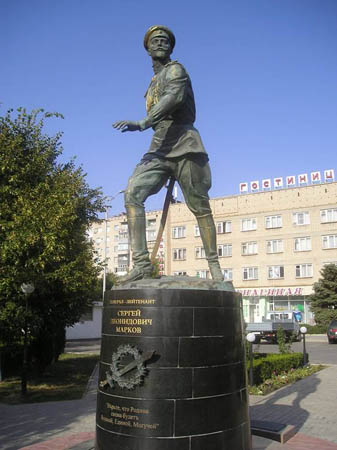 Today, the day of memory of St. Apostle Andrew Pervozvannogo, marks the 15th anniversary of the installation of the first in Russia new monument to the George Cavalry, a participant in the Russian-Japanese and Great Wars white general Sergei Markov . Markovtsev's regimental sign was a black and white St. Andrew’s flag.
Today, the day of memory of St. Apostle Andrew Pervozvannogo, marks the 15th anniversary of the installation of the first in Russia new monument to the George Cavalry, a participant in the Russian-Japanese and Great Wars white general Sergei Markov . Markovtsev's regimental sign was a black and white St. Andrew’s flag. 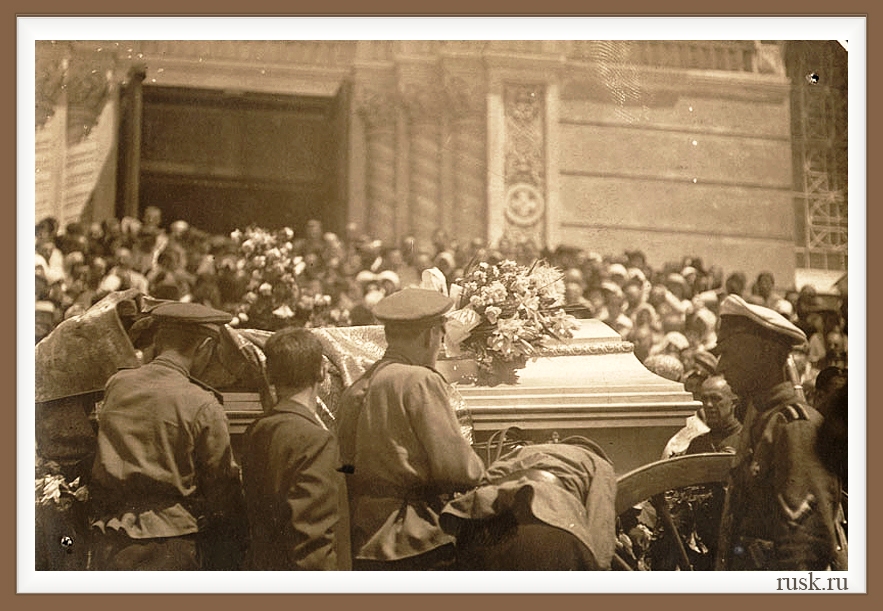
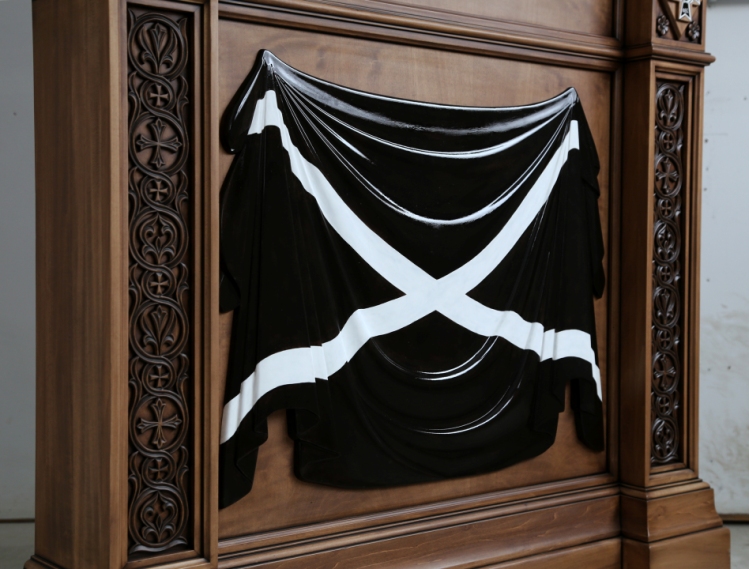
 Today, the day of memory of St. Apostle Andrew Pervozvannogo, marks the 15th anniversary of the installation of the first in Russia new monument to the George Cavalry, a participant in the Russian-Japanese and Great Wars white general Sergei Markov . Markovtsev's regimental sign was a black and white St. Andrew’s flag.
Today, the day of memory of St. Apostle Andrew Pervozvannogo, marks the 15th anniversary of the installation of the first in Russia new monument to the George Cavalry, a participant in the Russian-Japanese and Great Wars white general Sergei Markov . Markovtsev's regimental sign was a black and white St. Andrew’s flag. 

